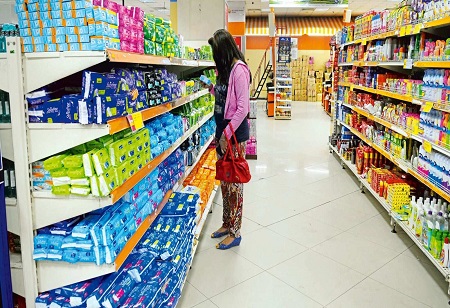
The FMCG industry in 2017 was worth $10,020.0 billion, and it is estimated to reach $15,361.8 billion by 2025, with a compound annual growth rate (CAGR) of 5.4% from 2018 to 2025.
In October 2023, the festive season had a positive impact on the trends of the Indian FMCG industry, resulting in buyers moving towards higher-value purchases in three out of the six categories within the sector. The increased purchasing of more expensive products in the FMCG industry caused a temporary halt in the trend of consumers choosing lower-priced options. It is worth mentioning that downtrading occurs when customers switch from buying larger packages to purchasing smaller ones. This observation was made across various categories until October.
“GST and demonetization have played a major role in driving the growth of FMCG in the urban as well as rural areas. This will improve the economic growth in a well-structured manner in the long term and will improve the performance of companies within the sector,” says Sanjiv Mehta, CEO, Hindustan Unilever. Also, the products are sold quickly at relatively low cost. FMCG is the fourth largest sector in the Indian economy with Food & Beverages, Household and Personal Care accounting for 83 percent of FMCG sales in India.
Also, the Indian Government has drafted a new Consumer Protection Bill and emphasized on setting up an extensive mechanism to ensure accessible, speedy, simple, on-time and affordable delivery to consumers. Because of higher minimum support price (MSP), disbursements through the Mahatma Gandhi National Rural Employment Guarantee Act (NREGA) programme and waiving loan to farmers by the government, the purchasing power of rural masses have been increased which ultimately boosts the FMCG consumption in India.
Clearly, the ongoing pandemic has accelerated the adoption of e-commerce platforms like never seen previously, leading to a significant increase in online spending. Today, a significant proportion of customers are resorting to online shopping either due to necessity or for the sake of convenience. Furthermore, the introduction of more secure online payment methods and the rapid development of efficient delivery systems have made it possible for customers to conveniently make purchases from any location. It is anticipated that online expenditure in India will increase significantly from $39 billion to $200 billion within the next 5 years. So unquestionably, these factors will drive the expansion of direct-to-consumer (D2C) brands, including fast-moving consumer goods (FMCG), in the country in the coming years.
The revolution of technology not just took place in urban India but rural India as well. There has been a noticeable shift in the demand of e-commerce due to its wider reach across the country, be it rural or urban areas. It has the greater consumer convenience as with the help of apps and websites, consumers can easily select and purchase the products of their choice and products will be delivered to their homes with the home delivery option.
The retail market in rural India and rise in rural consumption is also responsible for driving the FMCG market. Its contribution is 36 percent in the overall FMCG spending. The processed food market of India is projected to reach US$ 470 billion by the year 2025. The Indian FMCG industry grew with the support of consumption led growth and value expansion from higher product prices, particularly for staples.
It witnessed growth in double digits and reached 10.6 percent due to various government initiatives such as hygiene categories, high agricultural production, reverse migration and packaged staples. There is a contribution of different categories in FMCG sector such as Household & Personal Care, tobacco, Food & Beverages and others.
Agility is the pervasive sentiment in the FMCG sector and technology can provide this agility to the FMCG companies. With the help of technology, FMCG sector is further planning to improve operational efficiency, identify new opportunities and manage multifaceted supply chain requirements. FMCG relies heavily on the market research as it helps the sector to identify consumer behaviour and field sales professionals. With the use of advanced field service management software, enterprises leverage the power of cloud, business intelligence and data analysis to increase the performance of the sales operation.
The rural market of India is expected to reach up to US$ 220 billion by 2025. The rural consumption of India has increased which has led to combination of increasing incomes and higher aspiration level of masses. Another important factor that will drive the demand of FMCG in India is the growing percentage of young population in the country. It is a well known fact that India has the largest number of youth in the world and in today’s fast paced lifestyle, they prefer going with packaged food and products rather than preparing it on their own. This category contributes the largest amount of sales to the FMCG sector. With these developments, the FMCG sector looks all set to keep traversing the path of growth.
We use cookies to ensure you get the best experience on our website. Read more...